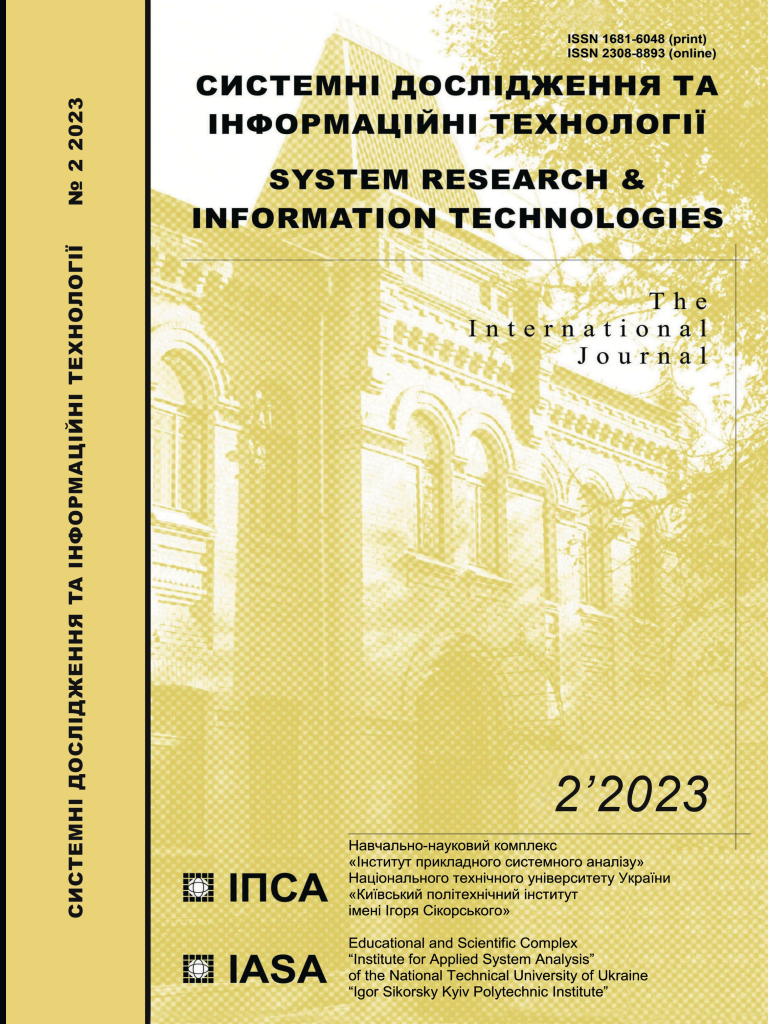Interval type-2 generalizing fuzzy model for monitoring the states of complex systems using expert knowledge
DOI:
https://doi.org/10.20535/SRIT.2308-8893.2023.2.05Keywords:
type-2 fuzzy model, interval membership function, set-theoretic approach, expert knowledgeAbstract
A type-2 interval generalizing fuzzy model is proposed for monitoring complex systems’ states. A set-theoretic approach is proposed to generalize the results of type-2 fuzzy models with interval membership functions. The study of the correspondence of expert assessments to the output value of the generalizing fuzzy model over the observation interval is presented. Examples of the use of generalizing fuzzy model type-2 in the task of monitoring the conditions of an artesian well are given. It is shown that in order to improve the quality of decisions made, the expert needs to pay attention to the value of the interval output of the generalizing type-2 fuzzy model. Recommendations are presented to experts to improve decision-making regarding the estimation of the output interval of the generalizing model.
References
Q. Liang and J.M. Mendel, “Interval Type-2 fuzzy logic systems: theory and design,” IEEE Trans. on Fuzzy Syst., vol. 8, pp. 535–550, 2000.
Y.P. Zaychenko, Fuzzy models and methods in intelligent systems, (in Russian). Kyiv: Slovo, 2008.
Arnab Kumar De, Debjani Chakraborty, and Animesh Biswas, “Literatura review on type-2 fuzzy set theory,” Soft Computing, 26 (18), pp. 9049–9068, 2022. doi: 10.1007/s00500-22-07304-4.
N.R. Kondratenko and O.O. Snihur, “Investigating adequacy of interval type-2 fuzzy models in comlex objects identification problems,” System Research and Information Technologies, no. 4, pp. 94–104, 2019.
N.R. Kondratenko, “Improving Adequacy of Type-2 Fuzzy Models by Using Type-2 Fuzzy Sets,” Naukovi visti NTUU KPI, no. 6, pp. 56–61, 2014.
Xiaoming Tang, Li Deng, JiminYu, and Hongchun Qu, “Output Feedback Predictive Control of Interval Type-2 T-S Fuzzy Systems With Markovian Packet Loss,” IEEE Transactions on Fuzzy Systems, vol. 26, no. 4, August 2018.
N.R. Kondratenko, O.V. Cheboraka, and O.A. Tkachuk, “Interval Type-2 Fuzzy Models Concerning Identification Problems of Multiple-input Multiple output Objects,” Information Processing Systems, no. 3(93), pp. 48–52, 2011.
N. Kondratenko and O. Snihur, “Interval Fuzzy Modeling of Comlex Systems under Conditions of Input Data Uncertainly,” Eastern-European Journal of Enterprise Technologies, vol. 4/4 (82), pp. 20–28, 2016.
N.R. Kondratenko, O.V. Cheboraka, and S.M. Kuzemko, “Study of Aggregating Interval Type-2 Fuzzy Models Capabilities for Forecasting of Time Series,” Visnyk VPI, no. 4, pp. 22–27, 2010.
N.R. Kondratenko, “Vykorystannya nechitkykh baz znanj z funktsiyamy nalezhnosti typu-2 u medychniy diahnostytsi [Use of fuzzy knowledge bases with type-2 membership functions in medical diagnostics],” Materials of the articles of the International scientific and practical conference “Actual problems of medical, biological physics and informatics”, Vinnytsia, 2022. Available: https://drive.google.com/file/d/1icajVT7OKyVxlfXZd1czwhS13EHtmUj8/view?usp=sharing
N.R. Kondratenko, N.B. Zelinsjka, and S.M. Kuzemko, “Fuzzy Logic Systems with Allovance for the Blank in Experimental Data Taken,” Naukovi visti NTUU KPI, no. 5, pp. 37–41, 2004.
P. Melin and O. Castillo, “An Intelleigent hybrid approach for industrial quality control combining neural networks, fuzzy logic and fractal theory,” Information Sciences, vol. 147, no. 177, pp. 1543–1557, 2007.

